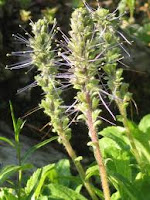Kuru is the English name for this plant which is native to the Indian subcontinent and the Himalayan area. It doesn’t grow in English-speaking countries, so there is no other name for it that this which takes the species name of the genus. It is a member of the Scrophulariaceae family, making it a distant relative of the snapdragon, toadflax, figwort, water figwort, brahmi or water hyssop, mullein, foxgloves and eyebright.
 It has spikes of flowers which are either purple or white, which flower between June and August. The rhizome is the part most often used in medicine and this is collected between the months of October and December. It is sold at markets, dried.
It has spikes of flowers which are either purple or white, which flower between June and August. The rhizome is the part most often used in medicine and this is collected between the months of October and December. It is sold at markets, dried. Unfortunately in the state of Himchal Pradesh in India , the plant is threatened and in danger of extinction because of over-harvesting of the root for medicinal purposes.
The root has traditionally been used for its liver protective actions and for the relief of joint pains and fevers. Some research has been done on it but the studies have not been replicated. Much more research needs to be done on this plant before it can be said absolutely that it can cure a particular disease.
However, that being said some studies have found that extracts of the root have anti-tumour activities perhaps due to the curcubitacin the root contains. Extracts of the rhizome have also been found to stimulate the immune system and to lower blood cholesterol levels. Others have shown that is an anti-periodic, which means that it can combat recurring diseases such as malaria, which is one of its traditional uses.
It has antibacterial properties and extracts of the rhizome are said to have a specific action against a tropical disease, leishmaniasis which is caused by a parasite. Traditionally it has also been used as an antidote to snake bites and scorpion stings.
In both Chinese traditional medicine and Ayurveda it is used to protect the liver and used against jaundice and other liver diseases. In these systems, the rhizome, stems and leaves are used.
 One study published in the BMC Journal of Complementary and Alternative Medicine, Banerjee, D. et al 2008 vol. 8 (3) “Healing potential of Picrorhiza kurroa (Scrophulariaceae) rhizomes against indomethacin-induced gastric ulceration: a mechanistic exploration” showed that it could heal stomach ulcers in vivo.
One study published in the BMC Journal of Complementary and Alternative Medicine, Banerjee, D. et al 2008 vol. 8 (3) “Healing potential of Picrorhiza kurroa (Scrophulariaceae) rhizomes against indomethacin-induced gastric ulceration: a mechanistic exploration” showed that it could heal stomach ulcers in vivo. Extracts of the root have anti-inflammatory properties as well as those mentioned above, plus anti-allergy properties, and have antioxidant ones as well. Apocynin can be extracted from the plant and this reduces platelet aggregation and is a powerful antioxidant and anti-inflammatory agent as well as being protective of the liver (hepaprotective).
Androsin, also presenting the plant is considered responsible for its anti-asthma (and allergy) actions.
More research is clearly needed into this plant, although it has been used safely for centuries without reports of damage to health.


















